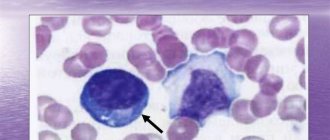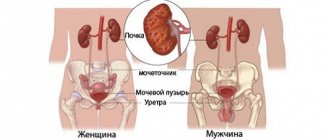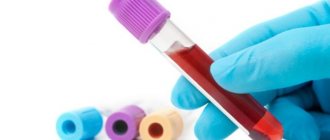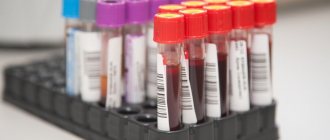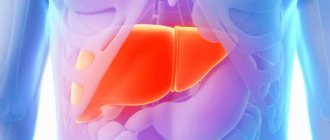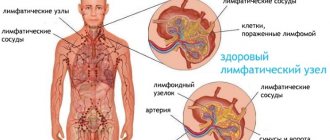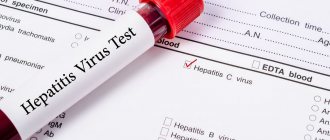Tests are a means of diagnosing diseases and assessing the condition of the body. One of the most informative diagnostic methods is a blood test, which allows you to identify even hidden pathologies such as appendicitis. In this article we will look at how this procedure is carried out and how to determine appendicitis using a blood test.
Prevention of appendicitis
At a time when human internal organs remained poorly understood, doctors were not able to localize inflammation.
Dissection of corpses was prohibited by medieval religion. Diseases of the cecum were studied by ancient scientists. Hippocrates wrote about severe intestinal suppuration, but did not know its causes. Cases of cure were rare. The cause of appendicitis was discovered only in the 16th century. The treatment methods offered were wild by modern standards. For example, doctors advised swallowing small lead balls to clear the cecal valve. Until the beginning of the 20th century, the causative agents of appendicitis were considered to be foreign bodies that had no way out of it, since there is no through passage through the cecum. Popular superstitions still contain advice on prohibiting the consumption of small, difficult-to-digest foods, for example, sunflower cake. In the 20th century, medicine achieved great development and refuted such misconceptions.
Intestinal diseases are affected by the following reasons:
- Poor nutrition;
- Bad habits such as smoking and alcohol;
- Harmful working conditions associated with toxins;
- Lack of food hygiene.
Once these factors are eliminated, the risk of appendicitis will decrease.
Appendicitis is an inflammatory process in the adnexal part of the cecum. The disease poses a danger not only to human health, but also to human life. Therefore, timely diagnosis is the main measure to prevent possible complications. A blood test for appendicitis helps determine how quickly the inflammatory process is progressing.
Blood test for appendicitis
To confirm the diagnosis, a set of diagnostic measures is used, an important place among which is a blood test. When deciphering the results, the values of the following indicators are especially important:
Clinical manifestations and symptoms of inflammation of the appendix
If catarrhal inflammation of the appendix, acute and uncomplicated by suppuration or rupture, has developed, then first discomfort, often sudden, appears in the abdomen.
There is no clear pain yet, but there may be bloating, distension, vague, wandering pain in the navel area. After 2-3 hours, the pain intensifies, it is localized in the lower right (in the iliac region) of the abdomen, and becomes constant, bursting and burning. It resembles the pain in a finger that was pinched by a door a minute ago. Any shock to the abdomen leads to a significant increase in pain, and to reduce it, the patient lies on his right side and brings his legs to the stomach to ease the tension of the peritoneum.
Usually patients endure the pain, but sometimes it reaches unbearable strength when the inflamed appendage becomes filled with pus and becomes severely stretched. Then we are talking about empyema of the appendix. Usually, with appendicitis, the pain does not move anywhere and does not radiate. After 6-8 hours, most patients develop an attack of nausea, vomiting once or twice, and appetite disappears. If there is an appetite and the stomach hurts, then the diagnosis of appendicitis is very doubtful.
A characteristic sign of appendicitis is impaired passage of stool and gas. Also, the first day the body temperature rises to low levels (low-grade fever). Also, protective muscle tension appears - abdominal defence, which does not allow the patient to deeply palpate the desired area of the abdomen, as well as characteristic symptoms of concussion (inflammation) of the peritoneum and blood test data.
Abdominal pain due to inflammation of the appendix
We remind you that an attack of acute appendicitis is not always accompanied by unbearable pain. The sensations may be moderate and disturbing, and the pain may resemble muscle pain. On the third or fourth day of the disease, the pain quickly subsides, the patient and those around him relax - and this leads to even greater prolongation, although it is a sign of a necrotic process when pain receptors in the membranes of the peritoneum stop working.
The result of this development of events is a periappendiceal abscess, which in a day or two turns into peritonitis. And here the chances of a favorable outcome are sharply reduced. Only an emergency and very complex operation can save the patient’s life.
Signs of appendicitis in a blood test in children
In childhood, appendicitis occurs more rapidly, so it is important to diagnose it in time. Symptoms of the disease in children are more pronounced
Counting blood cells helps to get a complete picture of the patient's condition. The number of leukocytes indicates the stage of development of the pathological process. At the catarrhal stage, the result may not exceed 12 units. In the phlegmonous form of the disease, the leukocyte level is between 16 and 18 units. When the indicator is above 18, we are talking about the gangrenous stage. It is considered the most life-threatening.
Children with appendicitis often show signs of dehydration. Vomiting may be present. The child's behavior changes, he becomes more capricious. Sometimes there is an increased urge to urinate and loose stools. The nature of the pain in most cases is acute and increasing. Determination based on a blood test and existing symptoms is considered the most accurate.
Indications for analysis
Appendicitis can be indicated by a large number of symptoms, and if they occur, you should consult a doctor. These include:
- A steady increase in temperature over several days.
- Loss of appetite.
- Weakness, fatigue.
- Nausea and vomiting.
- Painful urination.
- Cramps.
- Diarrhea.
- Sharp and nagging pain on the right side of the abdomen.
In some cases, the clinical picture is quite clear, which makes it easy to diagnose the disease. But with vague symptoms, additional examination methods are needed to confirm the development of the pathological process. In children, determining the presence of appendicitis is much more difficult, because they cannot always correctly indicate the source of the ailment. Therefore, if there is an unexplained change in behavior, increased irritability and pain, which disappears or significantly decreases when the body is positioned on the right side, it is necessary to consult a doctor as soon as possible.
What is the need for timely diagnosis?
Diagnostic procedures to identify acute appendicitis help assess the patient's condition. A blood test shows not only the inflammatory reaction of the appendix, but also other pathological processes in the body. To clarify the diagnosis, additional examination methods are prescribed. If the disease is not diagnosed on time, the following complications develop:
- abdominal abscess;
- complex form of pylephlebitis;
- peritonitis;
- appendicular infiltrate;
- intestinal obstruction.
No one is immune from the sudden development of the disease
Therefore, it is very important to know what tests to take to determine appendicitis. This will save time when making a diagnosis
Failure to do so could result in death.
Phlegmonous appendicitis is the third stage of inflammation occurring in the appendix of the caecum...
After timely diagnosis of the disease, surgery is performed. Initially, the abdominal cavity is freed from inflammatory exudate. For this purpose, special drainages are used. The procedure to remove the appendix is called an appendectomy. It is performed under general anesthesia.
In the chronic form of the disease, surgical procedures are also required. But first you should carry out antibacterial therapy. The patient is admitted to the hospital to prepare for surgical procedures. After surgery, the use of anti-inflammatory drugs is continued. They help prevent infection from entering internal organs.
How is acute appendicitis diagnosed?
The development of acute inflammation in the appendix can be suspected based on the clinical picture characteristic of this disease. The onset of inflammation is characterized by the appearance of painful sensations in the upper abdominal cavity, which, with the typical location of the appendix, descend to the right iliac region after a few hours.
In addition to pain, a sick person may experience nausea, general weakness, and dyspeptic disorders. With catarrhal changes, there are no symptoms of severe intoxication, that is, pulse and body temperature remain within normal limits. Subsequently, the catarrhal phase turns into destructive forms of appendicitis, in which case vomiting may occur, the pulse increases, and the temperature rises to 38 degrees or higher.
The symptoms listed above should already cause the doctor examining the patient to assume the development of appendicitis. To confirm and exclude this diagnosis, a number of examinations are prescribed, the most mandatory of which include blood and urine tests.
If possible, the patient undergoes an ultrasound of the abdominal organs, and, if necessary, radiography and computed tomography to exclude other pathologies. In addition to instrumental examinations, the patient, in addition to the attending surgeon, should be examined by other specialists - a therapist, a gastroenterologist. Women with an acute abdomen must be examined by a gynecologist to exclude ectopic pregnancy and acute adnexitis.
A presumptive diagnosis of appendicitis is made only with a cumulative assessment of all examinations, examinations and test data. And even if the diagnosis is in doubt, but most of the data suggests an acute pathology in the abdomen, then surgical intervention is prescribed. During the operation, the pathology is determined and a decision is made on further tactics for managing the patient.
Pathological stage
The transition to this stage will show that the permissible level of leukocytes is many times exceeded (2 times or more). The beginning of tissue breakdown threatens general blood poisoning. The accumulating liquid containing the remains of dead leukocytes in the form of suppuration becomes a source of intoxication. It can cause severe anaphylactic shock and coma. The proximity of the appendix to the lymph nodes is particularly dangerous. Only urgent surgery will save a patient with this form of the disease. Drug treatment cannot help in this case. People often die from medical errors when treating peritonitis.
Oak and oam for appendicitis
With appendicitis, discomfort is localized in the lower right part of the abdominal cavity. But pain in the right side during physical activity is not the main sign of the disease. Most often this is a consequence of muscle spasm or neuralgia. If painful sensations are accompanied by a thickening of the abdomen, which is located below and to the right of the navel, an increase in body temperature, and vomiting, this is a sure sign of a serious intestinal disease. Doctors consider a chemical study of blood composition to be the main indicator of the general condition of the body. A blood test for appendicitis is the main indicator of the presence or absence of this disease.
The chemical composition of human blood is a constant value. They donate blood for analysis in order to find out the quantitative relationships of its components. If the levels of white and red blood cells are increased, the composition of the plasma has changed, then you need to start treatment without delay.
A mandatory laboratory test for the presence of leukocytes in the blood is prescribed if inflammation of the appendix is suspected. During acute inflammatory processes, the composition of human blood changes due to the ingress of bacterial metabolic products into it. Leukocytes with appendicitis increase in size and number.
They are the main tool of immunity, but at the first stage of inflammation this increase is imperceptible. The state of red blood cells also changes. Their number is not subject to strong fluctuations, but inflammation shortens the lifespan of the red blood cell.
Urine also changes its composition, which correlates with the type of disease. The amount of dead leukocytes and red blood cells in it increases, the alkaline reaction changes, and the most severe cases are accompanied by the appearance of protein. To determine appendicitis using a blood test, it must be taken early in the morning on an empty stomach.
Blood tests for children are highly dependent on the individual condition of each child. The metabolic rate of a child's body is much higher than that of an adult. The leukocyte is actively involved in metabolism. Their amount in the blood of children significantly exceeds the proportions for older people.
The correct indicators for a mature person in relative values of leukocytes are from 4 to 8 units. In children they can reach 17. During pregnancy – 12-18. If leukocytes exceed 20, then there is a suspicion of peritonitis - a severe form of appendicitis that requires urgent surgical intervention. The decision about the severity of the disease should be made by specialized specialists - a pediatrician and a gastroenterologist. Since in acute peritonitis the patient’s death is likely due to blood poisoning, it is important not to miss the moment.
Other signs of appendicitis:
- Physiological signs. An increase in temperature, painful lumps in the lower abdomen, vomiting, and loose stools are the first external signs. If the disease has progressed, bloody discharge may appear in the stool and urine. In particularly difficult cases, a fistula develops with access to the skin.
- Changes in the composition of urine. The vital activity of pathogenic microorganisms is reflected in all body secretions. The kidneys separate metabolic products, signaling the onset of the disease by the changed chemical composition of the filtrate. If proteins appear in the general urine analysis, the bacterial background is increased, and its color takes on an unhealthy, cloudy appearance, this is a sure sign of internal inflammation.
- ESR. An ESR (erythrocyte sedimentation rate) analysis is designed to show what stage the disease is at. The activity of red blood cells varies depending on the state of the body. The inflammatory process provokes red blood cells to increase the consumption of their resources. ESR shows how long these cells live. Expressed in the height of the plasma layer and measured in millimeters per unit of time. In a healthy man it is 1-10 millimeters per hour, in a woman 3-15, in a child 12-17, in a newborn 0-2.
- However, only the results of a comprehensive examination, taking into account the total number of leukocytes and erythrocytes, will help to draw a conclusion about the nature of the disease.
Children are more susceptible to changes in blood composition. This makes it difficult to diagnose appendicitis in a timely manner. A child's blood contains a much larger number of leukocytes. Because of this, in children the disease at an early stage is easy to miss. It is accompanied by a relatively unnoticeable change in laboratory test results or is not diagnosed at all.
Pain syndrome is attributed to physical activity, general malaise to a cold, digestive problems to stress, and so on. If these signs are present, it is necessary to submit samples of discharge for testing for general composition. Sampling should only be done in the absence of stimuli. A comprehensive blood and urine test is designed to help identify the disease at this stage.
The cecum performs the function of storing enzymes necessary for digestion and immune function. It is isolated from the intestines, and this causes suppuration when the immune system is weakened.
Diagnosis based on a high white blood cell count clearly indicates inflammation. This condition is called leukocytosis. It is necessary to determine whether an acute inflammatory process has begun in cases of suspected appendicitis as quickly as possible! This disease is dangerous with complications. Prompt treatment with modern antibiotics and close clinical supervision can completely stop the disease at this stage. Strict adherence to the recommendations guarantees complete recovery, and failure to comply will lead the disease to the chronic stage.
The transition to this stage will show that the permissible level of leukocytes is many times exceeded (2 times or more). The beginning of tissue breakdown threatens general blood poisoning. The accumulating liquid containing the remains of dead leukocytes in the form of suppuration becomes a source of intoxication. It can cause severe anaphylactic shock and coma. The proximity of the appendix to the lymph nodes is particularly dangerous. Only urgent surgery will save a patient with this form of the disease. Drug treatment cannot help in this case. People often die from medical errors when treating peritonitis.
At a time when human internal organs remained poorly understood, doctors were not able to localize inflammation. Dissection of corpses was prohibited by medieval religion.
Diseases of the cecum were studied by ancient scientists. Hippocrates wrote about severe intestinal suppuration, but did not know its causes. Cases of cure were rare. The cause of appendicitis was discovered only in the 16th century. The treatment methods offered were wild by modern standards. For example, doctors advised swallowing small lead balls to clear the cecal valve. Until the beginning of the 20th century, the causative agents of appendicitis were considered to be foreign bodies that had no way out of it, since there is no through passage through the cecum. Popular superstitions still contain advice on prohibiting the consumption of small, difficult-to-digest foods, for example, sunflower cake. In the 20th century, medicine achieved great development and refuted such misconceptions.
Intestinal diseases are affected by the following reasons:
- Poor nutrition;
- Bad habits such as smoking and alcohol;
- Harmful working conditions associated with toxins;
- Lack of food hygiene.
Once these factors are eliminated, the risk of appendicitis will decrease.
source
Appendicitis is an inflammatory process localized inside a small extension of the cecum called the appendix. For a long time, people did not believe in the importance of the worm-shaped appendage for humans, but just 2-3 centuries ago, scientists found out that the appendage is an integral part of the immune system. By absorbing waste and toxins, the appendix cleanses the body of their harmful effects. However, if an increased amount of foreign bodies enters it, then without having time to eliminate them, the appendage begins to become inflamed.
The acute form of the disease, in the absence of immediate medical intervention, leads to peritonitis or liver abscess - these complications can cause painful death. A blood test for appendicitis (or suspected appendicitis), coupled with MRI, ultrasound and urine testing, can contribute to the timely detection of pathology. Therefore, you cannot refuse the diagnosis prescribed by a specialist.
The blood sampling procedure is indicated if the following symptoms are present:
- persistently elevated temperature for more than 6–7 days;
- fever;
- loss of appetite;
- chronic constipation;
- diarrhea;
- increased fatigue;
- muscle cramps;
- periodic attacks of sharp and nagging pain on the right side of the abdominal cavity;
- nausea;
- bloating;
- painful urination;
- vomit.
In children, it is much more difficult to determine the signs of appendicitis than in adults, since children, due to their age, are not able to indicate the exact location of the source of physiological discomfort. If a child experiences acute pain that only subsides when the body is positioned on the right side, you should seek medical help as soon as possible.
Of course, many of the listed signs indicate a wide range of diseases, but the combination of a number of symptoms is a reason for an unconditional visit to a medical facility.
A complete blood count (CBC) is carried out, oddly enough, in two ways. The first, most common type of hematology screening, involves taking capillary blood from the ring finger. The laboratory technician treats the phalanx pad with medical alcohol, wearing new disposable gloves before doing this, and makes a shallow puncture using a lancet equipped with a sterile thin needle.
When a drop of blood appears on the surface, the medical worker will begin to take a sample of the biomaterial, periodically squeezing the top of the finger. At the end of the procedure, a cotton pad is applied to the wound in order to stop further blood loss. Since young children often experience severe stress at the sight of “scary” laboratory instruments, some clinics have introduced small automatic scarifiers in bright colors.
The second method, based on taking blood from the ulnar vein, is used less frequently, but, unlike the previous one, it allows specialists to carry out, in parallel with the CBC, the determination of biochemical test parameters.
After applying a tourniquet to the shoulder, the nurse will clean the surface of the skin and ask you to actively clench and unclench your fist if necessary. Next, a needle is inserted into a clearly visible vessel, changing the angle of inclination.
When the syringe is filled with the required volume of blood, a sterile napkin is applied to the puncture site and the tourniquet is removed. If during the procedure a person experiences semi-fainting, numbness of the limbs, weakness or nausea, specialists should be notified immediately.
Appendicitis very often makes itself felt unexpectedly, therefore, during emergency delivery of a patient with obvious signs of inflammation, blood sampling is done immediately without appropriate preparation. The results of a routine test are usually provided the next day. An extract with marker indicators in intensive care will be ready within a few hours after the patient donates blood.
A blood test only shows objective parameter values when the patient has taken care in advance to prepare his body for the upcoming diagnosis. So, 2-3 days before screening, it is necessary to review the diet, excluding marinades, pickles, smoked foods, semi-finished products, instant foods, and fried foods. The main emphasis should shift towards light soups, baked vegetables, slimy porridges, salads and steamed lean meats.
The quantity of confectionery products should be reduced to a minimum. It is better to give preference to dark chocolate and natural marshmallows. The last meal should be in the evening of the last day of preparation, since you must come to the clinic on an empty stomach. You can bring a small bottle of still water with you to quench your thirst.
Smoking immediately before entering the office is strictly prohibited. Cigarettes are allowed at least 4 hours before laboratory testing. If you are using previously prescribed chemical drugs, you should make an appointment with a doctor at least a week in advance to clarify further actions in terms of limiting or completely eliminating medications before diagnosis.
Inflammation of the appendix cannot be diagnosed by any one parameter. There are 5 main blood markers, which together provide comprehensive information about the state of the body:
- Red blood cells. Red blood cells transport carbon dioxide and oxygen.
- ESR. One of the most indicative values is the erythrocyte sedimentation rate in a test tube. It indicates the intensity of the disease.
- S-RB. Immediately after the manifestation of an inflammatory focus, the liver synthesizes C-reactive protein, which suppresses the development of latent infection.
- Leukocytes. Blood cells detect pathogenic cells and viruses, attack them from all sides, and then eliminate them.
- Band neutrophils. These compounds are a type of white blood cell. In addition to providing internal protection, neutrophils also restore the structure of damaged tissues.
All markers must be located within the acceptable norm, which is reflected in the following table:
| Age category | Possible values of blood parameters | ||||
| ESR (mm/h) | S-RB (mg/l) | Red blood cells (×10^12/l) | Leukocytes (U/l) | Band neutrophils (%) | |
| Up to 20–25 days | 0–2,8 | 0–5 | 3,9–6,6 | 7–32 | 4–12 |
| 1–2 months | 2–5 | 2,7–5,4 | |||
| 3–6 months | 4–6 | 3,1–4,5 | 3–8 | ||
| 6–12 months | 3–10 | 3,4–5,2 | 2–7 | ||
| 2–5 years | 5–11 | 3,7–5 | 5–c15.5 | 1–6 | |
| 6–14 years | 4–12 | 3,5–5,5 | 4,5–13,5 | 1–5 | |
| 15–17 years old | 2–15 (for girls), 1–10 (for boys) | 3–5.5 (for girls), 3.9–5.6 (for boys) | 4,5–11 | 1–6 (for women), 1–7 (for men) | |
| 18-–30 years old | 8–15 (for women), 2–10 (for men) | 3–5.5 (for women), 4.2–5.6 (for men) | 4.0–10.5 (for women), 4.2–9.0 (for men) | ||
| 30–60 years | 8–20 (for women), 2–10 (for men) | 3.5–5.1 (for women), 4.0–5.6 (for men) | |||
| 60+ | 8–20 (for women), 2–15 (for men) | 3.4–5.2 (for women), 3.1–5.7 (for men) | 3.7–9.0 (for women), 3.9–8.5 (for men) | ||
If the number of red blood cells is minimal with an increased content of CRP, ESR, leukocytes and band neutrophils in the blood, then with a high degree of probability we can talk about the presence of progressive appendicitis in the patient. Since the indicators of pregnant women are often higher than normal, they are replaced by other diagnostic methods instead of OAC.
Often, a similar measure is used in relation to older people who have a weakened immune response. Many symptoms of an inflamed appendix resemble ectopic pregnancy, so female representatives sometimes have to donate blood for hCG levels. A result between 0 and 5.3 mIU/ml excludes gestation.
The cost of a blood test depends on which medical institution was chosen to perform the procedure. For example, in the northern regions of the Russian Federation, the price of a detailed study ranges from 240 to 600 rubles. In the European part of the country, the figure can exceed 900 rubles.
source
Laboratory research methods play a significant role in the complex diagnosis of many diseases. Acute and subacute appendicitis, in this case, is no exception to the rule.
Along with a blood test and other laboratory examination methods, a clinical urine test for appendicitis helps not only to identify inflammation of the appendix of the cecum, but also to differentiate this condition from other pathologies.
Despite the fact that this diagnostic technique is not capable of identifying specific markers of appendicitis, based on the results of a general clinical examination of urine, the presence of an inflammatory lesion of the appendix of the cecum can be assumed.
General clinical urine examination is a cost-effective and quite informative way to diagnose certain diseases. With regard to acute and subacute appendicitis, this diagnostic technique is indispensable when performing differential diagnosis.
Inflammatory lesions of the vermiform appendix of the cecum belong to those pathologies that have the general name “acute abdomen”. Such diseases include ectopic pregnancy in women, acute appendicitis, peritonitis and other serious diseases that require immediate surgical treatment.
By performing a general clinical examination of urine and other laboratory diagnostic procedures, medical specialists are able to accurately determine the nature of pathological changes, as well as the location of their localization. Such tactics can save the patient’s health and life.
The most important indicators in a clinical urine test for suspected appendicitis are protein casts, the level of leukocytes and erythrocytes, as well as the presence of infectious pathogens of a bacterial nature.
If a person has developed appendicitis, a urine test will show a noticeably increased number of leukocytes and red blood cells, and in 40% of cases, bacteriuria will be recorded. A simultaneous increase in the number of white blood cells and the appearance of bacteria in the urine is observed in patients with appendicitis, part of which is located near the ureter or bladder.
More than 30 leukocytes in the field of view indicate the development of acute and chronic diseases of the urinary system. The absence of this sign allows us to exclude organic and functional damage to the ureters, kidneys, bladder and urethra.
It is important to remember that clinical urine analysis cannot be used as the main method for detecting appendicitis. This type of laboratory diagnosis is informative only if used in combination with a clinical blood test, ultrasound examination of the abdominal cavity, general medical examination, and diagnostic laparoscopy (if necessary).
source
Appendicitis is an inflammatory process in the adnexal part of the cecum. The disease poses a danger not only to human health, but also to human life. Therefore, timely diagnosis is the main measure to prevent possible complications. A blood test for appendicitis helps determine how quickly the inflammatory process is progressing.
If appendicitis is suspected, there is severe pain in the right side of the abdomen. Discomfort in the peritoneum may be accompanied by an increase in body temperature, loss of consciousness and vomiting. The intensity of symptoms depends on the stage of neglect of the pathological condition. The main complication of inflammation of the appendix is its rupture. In this case, there is a risk of developing peritonitis.
Due to the vagueness of symptoms, appendicitis can be mistaken for other pathologies in the abdominal cavity and genitourinary system. Losing time can cost a person his life. Early diagnosis allows you to take timely measures. Therefore, it is important to study the characteristic features of appendicitis and what tests need to be taken to make a diagnosis.
Differences between blood tests in adults and children
The correct indicators for a mature person in relative values of leukocytes are from 4 to 8 units. In children they can reach 17. During pregnancy – 12-18. If leukocytes exceed 20, then there is a suspicion of peritonitis - a severe form of appendicitis that requires urgent surgical intervention. The decision about the severity of the disease should be made by specialized specialists - pediatrician and gastroenterologist
Since in acute peritonitis the patient’s death is likely due to blood poisoning, it is important not to miss the moment
Other signs of appendicitis:
- Physiological signs. An increase in temperature, painful lumps in the lower abdomen, vomiting, and loose stools are the first external signs. If the disease has progressed, bloody discharge may appear in the stool and urine. In particularly difficult cases, a fistula develops with access to the skin.
- Changes in the composition of urine. The vital activity of pathogenic microorganisms is reflected in all body secretions. The kidneys separate metabolic products, signaling the onset of the disease by the changed chemical composition of the filtrate. If proteins appear in the general urine analysis, the bacterial background is increased, and its color takes on an unhealthy, cloudy appearance, this is a sure sign of internal inflammation.
- ESR. An ESR (erythrocyte sedimentation rate) analysis is designed to show what stage the disease is at. The activity of red blood cells varies depending on the state of the body. The inflammatory process provokes red blood cells to increase the consumption of their resources. ESR shows how long these cells live. Expressed in the height of the plasma layer and measured in millimeters per unit of time. In a healthy man it is 1-10 millimeters per hour, in a woman 3-15, in a child 12-17, in a newborn 0-2.
- However, only the results of a comprehensive examination, taking into account the total number of leukocytes and erythrocytes, will help to draw a conclusion about the nature of the disease.
A shift of leukocytes to the left confirms appendicitis
[A complete blood count] shows a noticeable increase in leukocytes, and confirmation is the same shift to the left - on the scale of the percentage of certain types of cells, an increase in band neutrophils is clearly visible. It is their growth that indicates serious inflammation. The phase of the process can be clarified by the appearance of a shift to the right - the balance shifts towards segmented leukocytes with a clear increase in their number and an increase in ESR.
READ Causes and treatment of adhesions after appendicitis
A leukogram for inflammation of the appendix plays the role of not only confirmation, but also an indicator of the urgency of surgical intervention. When moving to a shift to the right, the decision is made taking into account the lack of time, since the process develops rapidly and towards the phlegmonous and perforative stages. And this is a direct threat of the occurrence of a periappendiceal abscess with transition to peritonitis.
Diagnostic features
For appendicitis, material is taken for analysis from a finger or, in some cases, from a vein. The procedure is painless. Leukocytes in appendicitis are above 18. This condition is quite understandable, because leukocytes in the human body are responsible for protection; if an infection or inflammation develops in the body, then these cells are the first to rush into battle, protecting the person from the consequences of the disease.
A study of the blood composition shows an increase in leukocytes in the catarrhal stage of inflammation to 9-12 thousand, and in the phlegmonous form to 17. If the figure is above 20 thousand, then an abscess or peritonitis is possible. When taking the test, take into account the individual characteristics of the human body, for example, during pregnancy, the level of leukocytes in the blood is normally always elevated, and this is not a deviation.
If you are wondering how to determine appendicitis yourself, pay attention to the characteristic signs; they are also a good reason to conduct a laboratory analysis. In case of inflamed appendicitis, a study in young children, men and women will show an increased content of leukocytes, and the patient himself will suffer from nausea, vomiting, severe abdominal pain, lethargy, pale skin
Pain during appendicitis is localized above the navel and radiates to the solar plexus. The patient develops a fever and becomes febrile.
An increase in intoxication of the body leads to stool disorders, constipation or diarrhea. The insidiousness of appendicitis is that the pain syndrome is easily relieved with painkillers, although degenerative changes continue to develop, becoming more intense every hour. If surgical procedures to remove the caecum are not started in a timely manner, it will rupture and infection will occur.
Diagnostic methods
For inflammation of the appendix, the main diagnostic methods are prescribed:
- primary examination - palpation;
- lab tests:
- blood;
- urine;
- instrumental research:
- computer, magnetic resonance imaging;
- ultrasound examination of the abdominal organs;
- medical thermography;
- laparoscopy;
- radiography.
Diagnostics allows you to detect the disease in a timely manner, prescribe effective treatment, and eliminate the pathology.
Initial examination
The first diagnostic method is an initial examination with palpation of the abdominal area. If the blood supply to the appendix is disrupted, strong, sharp pain is observed when pressing on the iliac region on the right side. In some clinical cases, the doctor may feel the inflamed appendix. The basic rule of palpation is to sharply release the hands after pressing on the abdomen. A description of associated symptomatic signs is an important part of the purpose of additional studies.
Lab tests
Submitting biological material for laboratory testing is important to determine further treatment for appendicitis. The exception is clinical cases when there is a serious complication that requires immediate surgical intervention to avoid the death of the patient. Based on the results of laboratory tests of blood and urine, it is possible to determine the cause of inflammation and eliminate possible problems with urination.
Biological material is collected to carry out the necessary tests:
- general blood and urine analysis if appendicitis is suspected;
- measuring the level of red blood cells, leukocytes;
- establishing the reactive protein indicator;
- determination of hCG level.
Establishing the number of leukocytes and erythrocytes contained in the blood allows us to identify the internal inflammatory process. Urine examination makes it possible to exclude diseases of the urinary system and determine the presence of pathogenic bacteria, infections, and viruses.
An increase in the number of leukocytes and red blood cells indicates the effect of an inflamed appendix on the urinary system. An indirect sign of damage to the vermiform appendage of the cecum is intense, dark color of urine.
Required parameters
The main indicator in laboratory analysis is the level of leukocytes in the blood. It indicates the presence of an internal inflammatory process and the nature of the pathology. Leukocytes in appendicitis have an indicator of 11-15 units in children, more than 18 in adults. High indices are grounds for emergency hospitalization and surgery. The predominance of the neutrophilic variety of leukocytes indicates that the inflammation becomes acute. Each person’s blood circulation is individual, therefore, to avoid inaccuracies, biological material is collected several times throughout the day.
Tests to determine inflammation of appendicitis involve determining the erythrocyte sedimentation rate. An increase in the indicator indicates an exacerbation of the pathology. Changes in hormonal balance during pregnancy in women are the cause of an unstable erythrocyte sedimentation rate index, as well as a possible slight increase in the level of white blood cells.
Signs of the inflammatory process are directly related to the level of reactive protein. Therefore, this indicator is not an infallible method for determining appendicitis, as it indicates a change in the functioning of any body system. For women, a blood test is required to determine the level of human chorionic gonadotropin (hCG) to distinguish appendicitis from signs of ectopic pregnancy. The accuracy of the result is ensured by the regularity and dynamism of the procedure.
Additional tests
In addition to a general blood test, which determines the content of leukocytes, and urine tests, they can take blood for analysis, where they will determine the leukocyte formula, C-reactive protein and hCG. The leukocyte formula shows the percentage of leukocyte elements. If there is inflamed appendicitis, then an increase in neutrophils is observed.
C-reactive protein begins to be produced by the liver when internal organs become inflamed. If the test results show elevated white blood cells, but the level of C-reactive protein is normal, then appendicitis can be ruled out immediately. The elevated protein itself is evidence of many diseases, so diagnosing appendicitis with its help is necessary only in combination with the number of leukocytes and the patient’s symptoms. The C-reactive protein level does not exceed 10 mg/l. If symptoms persist for 12 hours and the protein level is greater than 12, the doctor may diagnose appendicitis.
Since the signs of appendicitis are very similar to the symptoms of ectopic pregnancy, a blood test for hCG is performed. If a woman does have an ectopic pregnancy, the level of human chorionic gonadotropin will be increased if the presence of hCG in the woman's blood is negative in the blood test. Sometimes, the doctor sends the patient for ultrasound diagnostics of the peritoneal organs. The study will be decisive in the diagnosis of appendicitis.
A child, a woman or a man can experience inflammation of the appendage of the cecum, so it is much wiser to prevent the occurrence of inflammation by eating right and promptly eliminating urinary tract diseases. At the first symptoms, it is recommended to seek qualified help.
It is important to understand what tests need to be taken for appendicitis. All of them are practically painless and do not require any special effort from the patient himself.
As for the method of further treatment, it will be individual and developed only by a qualified specialist based on your symptoms and indicators. In most cases, surgical intervention is used.
Modern medicine is at a high level, and has already learned to deal with this pathology very well; cutting out appendicitis in most clinics is considered an ordinary procedure and does not pose a threat to the patient’s life. The rehabilitation process does not take more than 2 weeks, and after a month the patient himself can fully return to his normal life, restrictions will apply only to physical activity.
Decoding
When deciphering a general blood test for appendicitis, some features must be taken into account. For example:
It must be remembered that during pregnancy the leukocyte count and erythrocyte sedimentation rate are slightly higher than normal values. But at the same time, this condition is not considered pathological if no additional symptoms occur. In this case, it is recommended to use other diagnostic methods.
In older people, the leukocyte count may not reveal a pathological increase in leukocytes due to the age characteristics of the patient.
An hCG test is prescribed to exclude ectopic pregnancy, the symptoms of which can easily be confused with the development of appendicitis. In this case, elevated white blood cells will be found not only in the blood, but also in the urine.
Causes
The occurrence of the disease has a different nature of origin:
- mechanical: penetration of parasites, pathogenic bacteria;
- fecal stones;
- an increase in lymphatic follicles in the area of the cecal appendage;
- entry of a foreign object;
- chronic diseases of the pelvic organs;
- inflammation of blood vessels;
- infectious diseases: typhoid fever, tuberculosis, amoebiasis;
- pathologies of the endocrine and immune systems.
The main cause of inflammation is blockage of the appendix, which leads to the destruction of the internal microflora of the cecal appendage, compression of blood vessels and lymph nodes. In children, exacerbation of appendicitis occurs due to reduced immunity in winter and spring, and foreign objects entering the body.
Definition
Appendicitis is an inflammatory process occurring in the appendix of the cecum (appendix). Patients with this diagnosis make up a significant proportion of patients in surgical departments. Newborns and children suffer from this disease very rarely. This is due to the structural features of their body.
The disease tends to develop rapidly, which without immediate surgical intervention can lead to life-threatening complications. Appendicitis is also dangerous because in some cases the symptoms are quite vague, which makes it difficult to diagnose. To confirm the diagnosis, a set of emergency measures is used, not least of which is a blood test.
Leukocytes and their control
Since the role of leukocytes in the blood is leading, their concentration is usually determined in the following cases:
- When hospitalized in a hospital, a blood test will allow the doctor to make the correct diagnosis by comparing the indicators with symptoms and medical history.
- During a routine medical examination, children and adults undergo a blood test annually, which helps to monitor their health status and level of immunity, as well as to identify the presence of a disease that has a hidden course.
- According to indications, which may include such manifestations as:
poor weight gain or sudden weight loss in a child;
frequent acute respiratory infections and acute respiratory viral infections (1-2 times a month);
- indigestion;
- decreased vision.
It is important to monitor the level of leukocytes during the treatment of a certain disease, when the analysis is carried out before taking medication, during therapy and after it. This allows us to judge the effectiveness of therapy, as well as record the fact of recovery.
These cells should be constantly monitored during pregnancy and in childhood up to one year.
How to determine the presence of appendicitis by blood?
Inflammation of the appendix cannot be diagnosed by any one parameter. There are 5 main blood markers, which together provide comprehensive information about the state of the body:
- Red blood cells. Red blood cells transport carbon dioxide and oxygen.
- ESR. One of the most indicative values is the erythrocyte sedimentation rate in a test tube. It indicates the intensity of the disease.
- S-RB. Immediately after the manifestation of an inflammatory focus, the liver synthesizes C-reactive protein, which suppresses the development of latent infection.
- Leukocytes. Blood cells detect pathogenic cells and viruses, attack them from all sides, and then eliminate them.
- Band neutrophils. These compounds are a type of white blood cell. In addition to providing internal protection, neutrophils also restore the structure of damaged tissues.
| Age category | Possible values of blood parameters | ||||
| ESR (mm/h) | S-RB (mg/l) | Red blood cells (×10^12/l) | Leukocytes (U/l) | Band neutrophils (%) | |
| Up to 20–25 days | 0–2,8 | 0–5 | 3,9–6,6 | 7–32 | 4–12 |
| 1–2 months | 2–5 | 2,7–5,4 | |||
| 3–6 months | 4–6 | 3,1–4,5 | 3–8 | ||
| 6–12 months | 3–10 | 3,4–5,2 | 2–7 | ||
| 2–5 years | 5–11 | 3,7–5 | 5–c15.5 | 1–6 | |
| 6–14 years | 4–12 | 3,5–5,5 | 4,5–13,5 | 1–5 | |
| 15–17 years old | 2–15 (for girls), 1–10 (for boys) | 3–5.5 (for girls), 3.9–5.6 (for boys) | 4,5–11 | 1–6 (for women), 1–7 (for men) | |
| 18-–30 years old | 8–15 (for women), 2–10 (for men) | 3–5.5 (for women), 4.2–5.6 (for men) | 4.0–10.5 (for women), 4.2–9.0 (for men) | ||
| 30–60 years | 8–20 (for women), 2–10 (for men) | 3.5–5.1 (for women), 4.0–5.6 (for men) | |||
| 60 | 8–20 (for women), 2–15 (for men) | 3.4–5.2 (for women), 3.1–5.7 (for men) | 3.7–9.0 (for women), 3.9–8.5 (for men) | ||
If the number of red blood cells is minimal with an increased content of CRP, ESR, leukocytes and band neutrophils in the blood, then with a high degree of probability we can talk about the presence of progressive appendicitis in the patient. Since the indicators of pregnant women are often higher than normal, they are replaced by other diagnostic methods instead of OAC.
Often, a similar measure is used in relation to older people who have a weakened immune response. Many symptoms of an inflamed appendix resemble ectopic pregnancy, so female representatives sometimes have to donate blood for hCG levels. A result between 0 and 5.3 mIU/ml excludes gestation.
A small amount of feces will be enough for the study. It is not so easy to diagnose appendicitis. But still, stool tests will detect the presence of a problem in the intestines.
So, for example, it is enough to look at the color of the material collected for analysis. If the stool is black, foams and emits a too pungent and completely unbearable odor, you should think about it.
Why can feces act as an object for research? Because it is connected to the intestines, and the appendix is part of the digestive system. And if the appendix is overloaded and cannot cope with its duties, or even worse, it is overfilled and bursts, you will definitely see a reflection of this in the analyzes.
Other diagnostic methods
In an acute process, a general urine test sometimes helps - in a quarter of all hospitalized patients, the bladder or ureter begins to react to inflammation in certain anatomical positions of the appendix.
A survey X-ray of the abdominal cavity in most patients reveals increased airiness of the large intestine and half of the colon on the right, and with perforation (breakthrough of contents from the appendix) an accumulation of gas in the abdominal cavity is detected.
A research method such as ultrasound is very informative. It allows you to determine inflammation of the appendix in 90% of all patients. In this case, the appendix increases in diameter, its walls thicken, its shape changes, symptoms of mesenteric infiltration arise, and it is even possible to detect free fluid in the abdominal cavity. An experienced ultrasound doctor can determine acute appendicitis with an accuracy of up to 95% based on the visual picture alone.
Finally, the most informative method of direct visual diagnosis is diagnostic laparoscopy. If the doctor sees that the appendix and peritoneum are hyperemic, there are hemorrhages on the surface of the appendix, the mesentery is thickened, there is fibrin overlay on its surface and there is effusion in the abdominal cavity, then we are talking about indications for appendectomy.
If the patient has all of the above signs, and the picture is clear, then he will be taken for surgery and with a calm blood test, especially in the first few hours from the development of the disease. A blood test for appendicitis is an auxiliary diagnostic method; its role is to once again serve as a compelling argument for urgent surgery, or to postpone this operation for a while and leave the patient under dynamic observation.
In modern conditions, the importance of a general blood test for appendicitis, due to the introduction of ultrasound and diagnostic laparoscopy techniques, has decreased significantly. In the past, when the doctor was unable to visually evaluate the appendix by looking at it directly, he could only see it by opening the abdominal cavity. Of course, laparoscopy is much safer than laparotomy. But a general blood test, which is mandatory, and carried out cito (urgently), once again allows you to confirm the diagnosis of inflammation in the body, and gives additional confidence to the surgeon that it is necessary to perform an urgent operation.
Additional diagnostics and treatment
Only a doctor can determine which blood test for appendicitis will be most accurate. But due to the fact that this analysis may provide inaccurate information, additional diagnostic measures are necessary. These include:
Until the results of the prescribed tests are received and the diagnosis is confirmed, surgical intervention is performed extremely rarely. A qualified surgeon assesses the clinical picture of the disease and interprets the data obtained.
In the treatment of appendicitis, medications are used as symptomatic therapy, but the underlying pathology can only be treated surgically.
What analysis determines
The total content of leukocytes in the blood is determined using a CBC (complete blood count). Blood is taken from a finger, and the patient must prepare:
- do not eat or drink 3-4 hours before blood sampling;
- quit smoking and alcohol for a day;
- do not take any medications 3 days before the test.
The finger is well treated with alcohol, after which a puncture is made in the bundle. The first portion of blood is removed, since it may contain an excess number of cells from damaged capillaries, which will complicate the laboratory technician’s counting of leukocytes. Subsequent portions are divided into 1-2 test tubes (how many are needed is determined by the laboratory assistant), and a smear is prepared on a glass slide. This also allows for the following analyses:
- Coagulogram - helps to determine the percentage of all components in the total leukocyte mass.
- Leukogram - displays the percentage of leukocytes for every 100 other cells.
In some cases, when a severe inflammatory process is diagnosed, urine can be tested for leukocytes.
This helps determine the number of viable and dead cells, which will indicate the type of infection and the level of its progression.
Preparing for diagnosis
A blood test only shows objective parameter values when the patient has taken care in advance to prepare his body for the upcoming diagnosis. So, 2-3 days before screening, it is necessary to review the diet, excluding marinades, pickles, smoked foods, semi-finished products, instant foods, and fried foods. The main emphasis should shift towards light soups, baked vegetables, slimy porridges, salads and steamed lean meats.
You should forget about the existence of coffee and energy drinks with alcohol. The use of weak tea without flavorings, freshly squeezed juices, compotes and water comes to the fore.
The quantity of confectionery products should be reduced to a minimum. It is better to give preference to dark chocolate and natural marshmallows. The last meal should be in the evening of the last day of preparation, since you must come to the clinic on an empty stomach. You can bring a small bottle of still water with you to quench your thirst.
On the last day of preparation, you should stop any types of physical activity - they also contribute to changes in blood counts
Smoking immediately before entering the office is strictly prohibited. Cigarettes are allowed at least 4 hours before laboratory testing. If you are using previously prescribed chemical drugs, you should make an appointment with a doctor at least a week in advance to clarify further actions in terms of limiting or completely eliminating medications before diagnosis.
Goals of testing
If appendicitis is suspected, there is severe pain in the right side of the abdomen. Discomfort in the peritoneum may be accompanied by an increase in body temperature, loss of consciousness and vomiting. The intensity of symptoms depends on the stage of neglect of the pathological condition. The main complication of inflammation of the appendix is its rupture. In this case, there is a risk of developing peritonitis.
Due to the vagueness of symptoms, appendicitis can be mistaken for other pathologies in the abdominal cavity and genitourinary system. Losing time can cost a person his life. Early diagnosis allows timely action to be taken
Therefore, it is important to study the characteristic features of appendicitis, and what tests need to be taken to make a diagnosis.
Laparoscopy is a fairly common method of surgical intervention. It is used in many areas...
First of all, palpation and visual examination of the patient is performed. The following tests are also additionally performed:
- Women are required to donate blood for the hCG hormone. This will eliminate the possibility of an ectopic pregnancy.
- Urinalysis helps distinguish appendicitis from urological diseases.
- The leukocyte formula is involved in identifying the source of the inflammatory process in the body. It shows the percentage of white blood cells.
- A test that determines the amount of C-reactive protein allows you to identify the origin of the inflammatory process in the body.
- A complete blood count is performed to identify leukocytes and other blood parameters.
The appendix is located on the right side of the abdominal cavity. Its upper part touches the liver, and the lower part is localized in the pelvis. The focus of pain depends on where the source of inflammation is located. If pain occurs in women, it is necessary to exclude the possibility of gynecological diseases. For this purpose, an analysis is done for hCG, an ultrasound of the genital organs is performed, and the regularity of the menstrual cycle is analyzed.
HCG is considered a pregnancy hormone. In pregnant women, it increases every 2 days. During pathological processes in the body, its growth can either slow down or accelerate. If appendicitis develops during pregnancy, hCG will help determine the condition of the child. Stopping or slowing the growth of the hormone indicates an unfavorable outcome.
Sometimes appendicitis is confused with urological diseases. Their distinctive feature is burning and discomfort during urination. With appendicitis, the urge to urinate may become more frequent. Other symptoms characteristic of urological diseases do not appear.
One of the most important indicators in diagnosing appendicitis is C-reactive protein. It is a blood plasma substance produced by the liver. In a healthy person, the level of this indicator does not rise above 10 mg/l. An increase in the amount of protein in the body indicates an inflammatory process in the peritoneum. It is not always concentrated specifically in the appendix. If C-reactive protein does not exceed the norm, then there is no appendicitis.
What tests for appendicitis can be taken additionally?
Sometimes doctors need additional confirmation and determination of the diagnosis. To do this, they may well take a urine test. Based on the color it will have, as well as the number of the same leukocytes, doctors determine the presence of a serious pathology.
It is recommended to take a urine test in any case; it will allow you to make a diagnosis faster and more accurately. Although urine analysis is not particularly related to the intestines, it also allows you to quickly track pathological changes in the body.
It is also worth doing an ultrasound to determine appendicitis. It will show as accurately as possible that there is such a problem as inflammation of the appendix. And, as a rule, this kind of research must be carried out in a complex manner.
Results
Tests for appendicitis are an essential component of diagnosing the disease. But it should be remembered that a final diagnosis is not made based on the results of blood and urine tests. A combination of various factors must be taken into account. At the initial stage of the inflammatory process, the pain may be dull. It is highly recommended not to ignore it. You must consult a doctor immediately.
Appendicitis is an inflammation of the appendix of the cecum. Untimely removal of the appendage leads to the development of complications: intestinal perforation and the onset of peritonitis. The most dangerous consequence of the pathology is death. In the absence of pronounced symptomatic signs in elderly people and children, laboratory tests of blood, urine and instrumental examination can determine possible inflammation of the appendix.
Laboratory analysis – for what?
Symptoms of inflammation of the appendix:
- pain in the right hypochondrium;
- temperature increase;
- attacks of nausea.
Sometimes the symptoms are vague, which is why inflammation of appendicitis is mistaken for other pathologies of the abdominal cavity or diseases of the genitourinary system. A blood test for appendicitis in adults and children is a method that will allow you to make a correct diagnosis in time for latent symptoms or atypical forms of the disease.
A blood test for appendicitis will help make an accurate diagnosis if the symptoms are vague.
In older people, it is more difficult to detect inflammation of appendicitis using a blood test, since their leukocyte levels are slightly elevated. Your doctor will tell you in detail how to determine appendicitis using a blood test .
The level of leukocytes in the blood is different for everyone
You should not think that everyone’s test results are the same, that is, if leukocytes are elevated, it means there is appendicitis. This is absolutely not true. In young people, the indicators may, on the contrary, be reduced, and in the elderly they may be completely absent. It is also worth considering the fact that after the operation the level of leukocytes does not immediately return to normal, but a certain time must pass. In this case, the doctor prescribes certain medications for recovery, as well as appropriate nutrition. This is explained by the fact that there is also an inflamed wound, which, despite all treatments, still becomes inflamed. Everything happens gradually, so leukocytes are restored only when the wound is completely healed and, accordingly, when the body’s condition is restored.
If a leukocyte level of more than 9 was detected during appendicitis, then at the time of discharge this figure should not exceed itself. The patient may be left in the hospital until complete recovery if leukocytosis continues and the levels do not decrease. In this case, additional treatment is prescribed, followed by a repeat blood test. The main thing to remember is that the presence of elevated white blood cells is the first sign of inflammation in the body, and this cannot simply be left alone.
